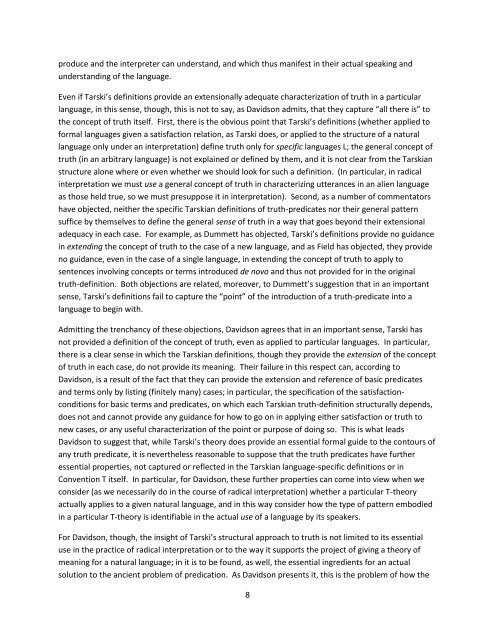Heidegger, Tugendhat, Davidson - University of New Mexico
Heidegger, Tugendhat, Davidson - University of New Mexico
Heidegger, Tugendhat, Davidson - University of New Mexico
You also want an ePaper? Increase the reach of your titles
YUMPU automatically turns print PDFs into web optimized ePapers that Google loves.
produce and the interpreter can understand, and which thus manifest in their actual speaking and<br />
understanding <strong>of</strong> the language.<br />
Even if Tarski’s definitions provide an extensionally adequate characterization <strong>of</strong> truth in a particular<br />
language, in this sense, though, this is not to say, as <strong>Davidson</strong> admits, that they capture “all there is” to<br />
the concept <strong>of</strong> truth itself. First, there is the obvious point that Tarski’s definitions (whether applied to<br />
formal languages given a satisfaction relation, as Tarski does, or applied to the structure <strong>of</strong> a natural<br />
language only under an interpretation) define truth only for specific languages L; the general concept <strong>of</strong><br />
truth (in an arbitrary language) is not explained or defined by them, and it is not clear from the Tarskian<br />
structure alone where or even whether we should look for such a definition. (In particular, in radical<br />
interpretation we must use a general concept <strong>of</strong> truth in characterizing utterances in an alien language<br />
as those held true, so we must presuppose it in interpretation). Second, as a number <strong>of</strong> commentators<br />
have objected, neither the specific Tarskian definitions <strong>of</strong> truth-predicates nor their general pattern<br />
suffice by themselves to define the general sense <strong>of</strong> truth in a way that goes beyond their extensional<br />
adequacy in each case. For example, as Dummett has objected, Tarski’s definitions provide no guidance<br />
in extending the concept <strong>of</strong> truth to the case <strong>of</strong> a new language, and as Field has objected, they provide<br />
no guidance, even in the case <strong>of</strong> a single language, in extending the concept <strong>of</strong> truth to apply to<br />
sentences involving concepts or terms introduced de novo and thus not provided for in the original<br />
truth-definition. Both objections are related, moreover, to Dummett’s suggestion that in an important<br />
sense, Tarski’s definitions fail to capture the “point” <strong>of</strong> the introduction <strong>of</strong> a truth-predicate into a<br />
language to begin with.<br />
Admitting the trenchancy <strong>of</strong> these objections, <strong>Davidson</strong> agrees that in an important sense, Tarski has<br />
not provided a definition <strong>of</strong> the concept <strong>of</strong> truth, even as applied to particular languages. In particular,<br />
there is a clear sense in which the Tarskian definitions, though they provide the extension <strong>of</strong> the concept<br />
<strong>of</strong> truth in each case, do not provide its meaning. Their failure in this respect can, according to<br />
<strong>Davidson</strong>, is a result <strong>of</strong> the fact that they can provide the extension and reference <strong>of</strong> basic predicates<br />
and terms only by listing (finitely many) cases; in particular, the specification <strong>of</strong> the satisfactionconditions<br />
for basic terms and predicates, on which each Tarskian truth-definition structurally depends,<br />
does not and cannot provide any guidance for how to go on in applying either satisfaction or truth to<br />
new cases, or any useful characterization <strong>of</strong> the point or purpose <strong>of</strong> doing so. This is what leads<br />
<strong>Davidson</strong> to suggest that, while Tarski’s theory does provide an essential formal guide to the contours <strong>of</strong><br />
any truth predicate, it is nevertheless reasonable to suppose that the truth predicates have further<br />
essential properties, not captured or reflected in the Tarskian language-specific definitions or in<br />
Convention T itself. In particular, for <strong>Davidson</strong>, these further properties can come into view when we<br />
consider (as we necessarily do in the course <strong>of</strong> radical interpretation) whether a particular T-theory<br />
actually applies to a given natural language, and in this way consider how the type <strong>of</strong> pattern embodied<br />
in a particular T-theory is identifiable in the actual use <strong>of</strong> a language by its speakers.<br />
For <strong>Davidson</strong>, though, the insight <strong>of</strong> Tarski’s structural approach to truth is not limited to its essential<br />
use in the practice <strong>of</strong> radical interpretation or to the way it supports the project <strong>of</strong> giving a theory <strong>of</strong><br />
meaning for a natural language; in it is to be found, as well, the essential ingredients for an actual<br />
solution to the ancient problem <strong>of</strong> predication. As <strong>Davidson</strong> presents it, this is the problem <strong>of</strong> how the<br />
8
















